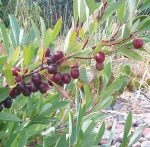 This deciduous suckering, spreading shrub is native to the Northern Great Plains from Manitoba to Wyoming and Colorado, east to Minnesota and Kansas where it grows on sandy hills, rocky slopes and in open plains. It is a member of the rose family, Rosaceae, that also includes almonds, peaches, and lady’s mantle. The relatively short-lived plants grow 4-6′ tall and wide, and have leathery oval to oval-lanceolate leaves that are 1-2″ long, have finely toothed margins, and are dark to grayish green before tuning mahogany red in the fall. In spring clusters of 2-4 fragrant white flowers appear that have 5 petals, are 1/3″ across, and give rise to round, 1/2″ wide black edible fruits that are attractive to numerous songbirds. In addition, the growth habit of the plants provides roosting and loafing cover for song- and gamebirds, and nesting cover for songbirds. Plants tolerate cold, heat, wind and drought so are useful for hedges, screens, and windbreaks in xeriscapes, and seaside gardens. The genus name, Prunus, comes from the Greek word προύνη meaning plum, a prominent member of this genus. The specific epithet, besseyi, honors Charles E. Bessey (1845-1915), American botanist, who significantly contributed to botanical education in the U.S.
This deciduous suckering, spreading shrub is native to the Northern Great Plains from Manitoba to Wyoming and Colorado, east to Minnesota and Kansas where it grows on sandy hills, rocky slopes and in open plains. It is a member of the rose family, Rosaceae, that also includes almonds, peaches, and lady’s mantle. The relatively short-lived plants grow 4-6′ tall and wide, and have leathery oval to oval-lanceolate leaves that are 1-2″ long, have finely toothed margins, and are dark to grayish green before tuning mahogany red in the fall. In spring clusters of 2-4 fragrant white flowers appear that have 5 petals, are 1/3″ across, and give rise to round, 1/2″ wide black edible fruits that are attractive to numerous songbirds. In addition, the growth habit of the plants provides roosting and loafing cover for song- and gamebirds, and nesting cover for songbirds. Plants tolerate cold, heat, wind and drought so are useful for hedges, screens, and windbreaks in xeriscapes, and seaside gardens. The genus name, Prunus, comes from the Greek word προύνη meaning plum, a prominent member of this genus. The specific epithet, besseyi, honors Charles E. Bessey (1845-1915), American botanist, who significantly contributed to botanical education in the U.S.
Type: Deciduous shrub
Outstanding Feature: Flowers, berries
Form: Sprawling
Growth Rate: Moderate
Bloom: Clusters of 2-4 fragrant white flowers in early spring
Size: 3-6′ H x 3-6′ W
Light: Full sun
Soil: Average, medium moist, well-drained; drought tolerant
Hardiness: Zones 3-7
Care: Prune out weak, damaged, and diseased branches in spring.
Pests and Diseases: Taphrina leaf curl, black knot, and fireblight.
Propagation: Cuttings
Photo Credit Wikipedia